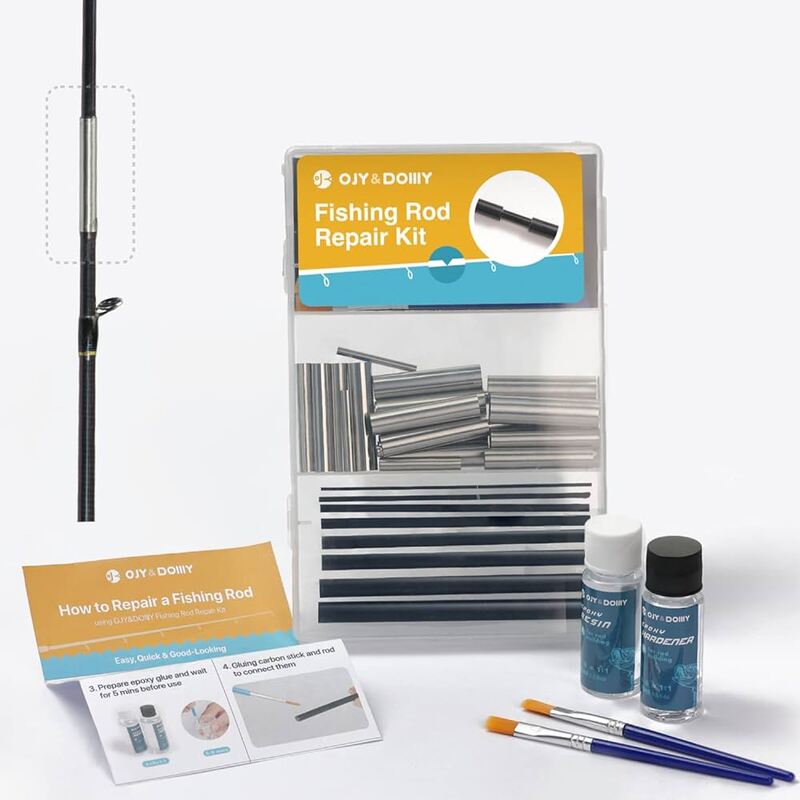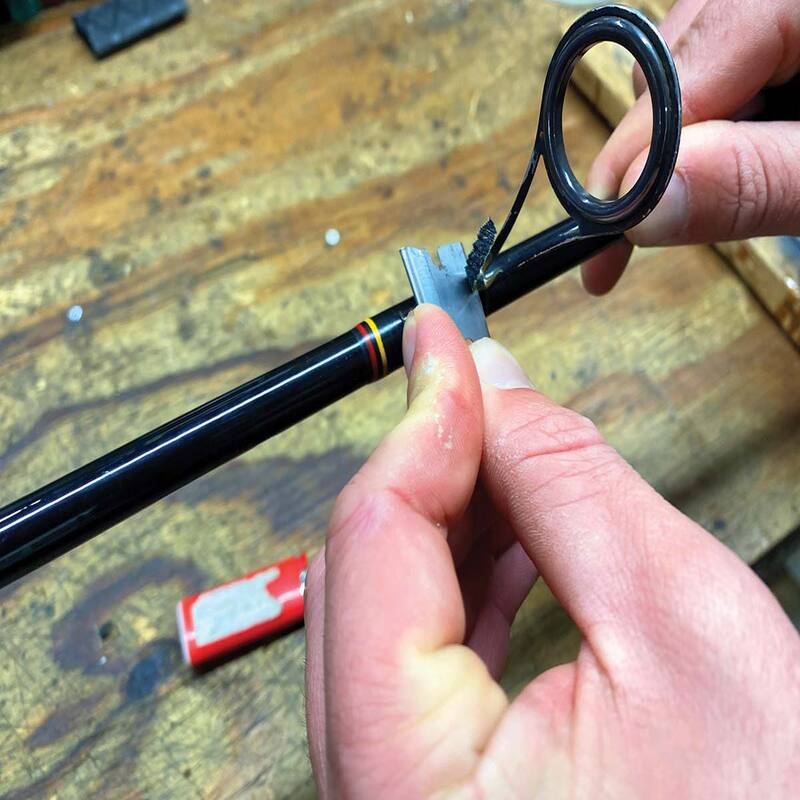How to fix a fishing rod? A damaged fishing rod can be a frustrating setback for any angler, but many common issues are fixable with the right tools and techniques. Learning how to repair your rod not only saves time but also extends the life of your equipment. Therefore, understanding the steps involved in identifying damage, carrying out repairs, and maintaining your rod is essential. This comprehensive guide explores common types of rod damage, repair methods, and tips for preventing future issues. By following these insights, you can ensure your fishing rod remains in optimal condition, ready for your next adventure.
Common Types of Fishing Rod Damage
Fishing rods can suffer from various types of damage, each requiring specific repair methods. Therefore, exploring common damage types helps you identify and address issues effectively.
Broken or Cracked Rod Blank
One of the most severe types of damage is a broken or cracked rod blank. This can occur due to excessive pressure, improper handling, or impact. A broken blank compromises the rod’s structural integrity, making it unusable. While some severe breaks may require professional repair or replacement, minor cracks can often be repaired at home. Identifying the extent of the damage is the first step in determining the appropriate repair method. Therefore, recognizing the impact of a broken or cracked rod blank underscores the importance of careful inspection.
Damaged or Missing Guides
Guides, also known as rod rings, are crucial components that direct the fishing line along the rod. Damaged or missing guides can lead to line tangling, fraying, or breakage. Common causes of guide damage include rough handling, striking against hard surfaces, or wear and tear over time. Replacing or repairing guides is a relatively straightforward process, requiring some basic tools and materials. Identifying damaged guides early helps prevent further issues and ensures smooth line movement. Therefore, understanding the significance of damaged or missing guides highlights the need for routine inspection.

Tools and Materials to Fix a Fishing Rod
Having the right tools and materials is essential for successful fishing rod repairs. Therefore, exploring these necessary items helps you prepare for effective maintenance.
Basic Repair Tools
Basic tools for fishing rod repairs include a utility knife, pliers, sandpaper, and scissors. These tools assist in cutting, shaping, and removing damaged components. Additionally, a lighter or heat gun is useful for heating and securing certain adhesives. Pliers help in removing and installing guides, while sandpaper smoothens rough edges and surfaces. Having these basic tools readily available ensures you can perform a variety of repair tasks efficiently. Therefore, recognizing the importance of basic repair tools highlights their role in successful rod maintenance.
Essential Repair Materials
Essential materials for rod repairs include epoxy resin, rod tip glue, replacement guides, and thread wrap. Epoxy resin is vital for repairing cracked or broken rod blanks, providing a strong and durable bond. Rod tip glue is specifically designed to secure replacement tips and guides, ensuring they remain firmly in place. Replacement guides and thread wrap are necessary for restoring damaged or missing guides. Having these materials on hand ensures you can address common repair needs promptly. Therefore, understanding the significance of essential repair materials highlights their necessity in effective rod repairs.
Step-by-Step Guide to Fix a Fishing Rod
Repairing a fishing rod involves several steps, each tailored to address specific issues. Therefore, exploring these steps provides a clear and comprehensive repair process.
Repairing a Broken or Cracked Rod Blank
To repair a broken or cracked rod blank, start by cleaning the damaged area with sandpaper to remove any debris and smooth rough edges. Apply epoxy resin evenly over the cracked area, ensuring it penetrates any crevices. Align the rod pieces carefully, maintaining the rod’s original shape and alignment. Secure the repair area with masking tape or clamps until the epoxy cures completely, usually 24 hours. Once cured, sand the repaired area to ensure a smooth finish. Properly repairing a broken or cracked rod blank restores its strength and functionality. Therefore, recognizing the importance of proper alignment and curing underscores the effectiveness of the repair method.
Replacing Damaged or Missing Guides
Replacing damaged or missing guides involves removing the broken guide and securing the replacement. First, carefully cut and remove the old guide using a utility knife or pliers. Clean the area where the new guide will be installed, removing any old thread or adhesive. Position the replacement guide, ensuring it aligns with the other guides on the rod. Secure the new guide with thread wrap, covering the entire base of the guide foot. Apply a thin layer of rod tip glue or epoxy over the thread wrap to secure it. Allow the adhesive to cure completely before using the rod. Therefore, understanding the importance of alignment and secure wrapping ensures a successful guide replacement.

Preventive Maintenance Tips for Fishing Rods
Regular maintenance helps prevent damage and extends the life of your fishing rod. Therefore, exploring preventive tips ensures your rod remains in optimal condition.
Routine Inspection
Routine inspection is crucial for identifying potential issues before they become major problems. Regularly examine the rod blank, guides, and reel seat for any signs of damage, wear, or loosening. Pay attention to any cracks, bends, or missing components. Check the guides for any rough edges or misalignment that could damage the fishing line. Addressing minor issues promptly helps prevent more significant damage, ensuring your rod remains functional. Therefore, recognizing the importance of routine inspection highlights its role in preventive maintenance.
Proper Storage Practices
Proper storage practices are essential for preserving your fishing rod’s condition. Store your rods in a cool, dry place, away from direct sunlight to prevent material degradation. Use rod covers or tubes to protect the rods from physical damage during transportation and storage. Avoid placing heavy objects on top of your rods, as this can cause bending or breakage. Keeping your rods clean and dry also helps prevent corrosion and deterioration. Therefore, understanding the significance of proper storage practices highlights their impact on the longevity of your fishing rod.
Common Misconceptions to Fix a Fishing Rod
There are several misconceptions about fishing rod repairs that can hinder effective maintenance. Therefore, exploring these misconceptions clarifies important aspects of rod repair.
Repairing Rods Reduces Performance
A common misconception is that repairing fishing rods significantly reduces their performance. While improper repairs can affect a rod’s effectiveness, correctly executed repairs restore functionality and preserve performance. Using high-quality materials and following proper repair techniques ensures the rod regains its original strength and flexibility. In many cases, a well-repaired rod performs similarly to a new one. Therefore, understanding the importance of proper repair techniques dismisses the misconception that repairs inherently reduce performance.
Only Experts Can Repair Fishing Rods
Another misconception is that only experts can effectively repair fishing rods. While professional repair services are valuable for complex issues, many common repairs are straightforward and can be done at home. With the right tools, materials, and guidance, anglers can address issues like broken tips, damaged guides, and minor cracks. Learning basic repair techniques empowers anglers to maintain their rods and handle minor repairs independently. Therefore, recognizing the accessibility of rod repairs highlights the potential for anglers to perform effective maintenance themselves.

When to Seek Professional Help
In some cases, professional help may be necessary for certain rod repairs. Therefore, exploring these situations helps determine when to consult an expert.
Complex Breaks or Cracks
For complex breaks or severe cracks in the rod blank, professional assistance is often required. Professional rod builders have specialized equipment and expertise to properly realign and reinforce the rod. They can ensure the repair maintains the rod’s integrity and performance. Attempting to repair severe damage without the necessary skills or tools can result in further damage. Therefore, recognizing the need for professional help with complex issues ensures the rod is effectively and safely repaired.
Warranty Considerations
If your fishing rod is still under warranty, consulting the manufacturer or a professional for repairs is advisable. Many warranties cover specific types of damage and provide repair or replacement services. Attempting DIY repairs on a warranted rod can void the warranty and result in financial losses. Contacting the manufacturer ensures repairs are performed according to their standards and specifications. Therefore, understanding warranty considerations highlights the importance of professional assistance for covered rods.
Conclusion
Fix a fishing rod involves identifying damage, using the right tools and materials, and following proper repair techniques. Proper knowledge ensures effective and lasting repairs.
Exploring elements like common damage types, recognizing the significance of basic tools and materials, and identifying the importance of preventive maintenance provides valuable insights into rod repairs. Recognizing the need for proper alignment, secure wrapping, and routine inspection further enriches the understanding.
By engaging with tips for preventive maintenance and knowing when to seek professional help, you can ensure your fishing rod remains in top condition. Therefore, whether you encounter minor issues or more complex damage, understanding these aspects offers practical and valuable insights. Embrace the opportunity to maintain and repair your fishing rod, knowing you have the knowledge and resources to keep it functional and ready for your next fishing adventure!
